Executive Summary
- New equipment saves almost $50,000 per year in equipment, labor and consumable costs.
- Millermatic 350P Pulsed MIG welder and XR Aluma-Pro gun allowed Metal Shark to increase productivity and improve weld quality.
- Reduced heat input of Miller system allows for continuous welding without cooling.
- New system cuts one whole day from assembly of the hull.
- Efficiencies in consumables and labor costs paid for the new equipment in 4-1/2 months.
Boat Maker Cruises From Fabricating to Manufacturing
New aluminum welding system saves almost $50,000 per year, cuts welding time in half, allows for mass production
For a company accustomed to building fishing boats to order, a U.S. Coast Guard contract presents some unique challenges. When the Coast Guard orders 100 boats, boat #100 has to be identical to boat #1, or they won’t take delivery.
To succeed, the company will have to make the transition from fabricator to manufacturer as well as adopt production techniques that will ensure repeatability and efficiency.
 |
The TANB (Trailerable Aid to Navigation Boat) will play an important part in the U.S. Coast Guard’s new streamlined small boat fleet.
|
When Metal Shark Aluminum Boats of Jeanerette, La., won the contract to provide the Coast Guard with 100 aluminum TANBs (Trailerable Aids to Navigation Boats), Jimmy Gravois, company president, had to make some changes. For instance, instead of sketching everything by hand, he began using a CAD drawings and a CNC waterjet to precisely water-cut the boat components and using steel jigs to ensure conformity.
The transition also meant hanging up the trusty spool guns and traditional welding power sources that had served him well before. In their place, Gravois turned to aluminum welding systems composed of Millermatic® 350P pulsed MIG welders with XR™-Aluma-Pro™ push pull guns. The result: Metal Shark increased efficiency, doubled production and cut welding time in half for some operations.
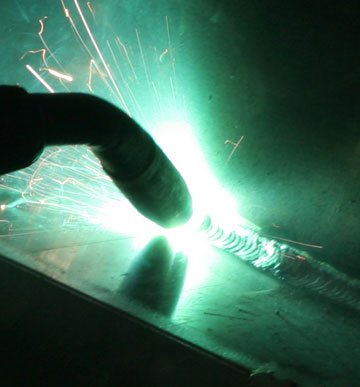 |
The Millermatic 350/XR-Aluma-Pro allows the welding operator to make long continuous welds without putting too much heat into the weld or experience feeding problems.
|
By the time they reached the tenth boat, Metal Shark went from providing the contract’s required one boat every 18 days to often providing two boats in that same time period. By using the new Miller aluminum welding systems instead of the old spool gun systems, Metal Shark saves one day per boat in welding time and uses 16-lb. spools of 3/64-in. wire instead of 1-lb. spools of .035-in. wire. Compared to using the older spool gun/spray transfer system, Metal Shark is saving $49,695 per year, enough to have paid for the three new XR-Aluma-Pro/Millermatic 350P systems in four and one-half months.*
Fast, Versatile, Repeatable
The Coast Guard is standardizing its small boat fleet in an effort to reduce crew-training time and improve effectiveness. When the program is completed, the Coast Guard’s small-boat fleet will go from hundreds of different types to fewer than 10. These new, multi-mission boats will share common systems and reduce the variations between boats of the same type.
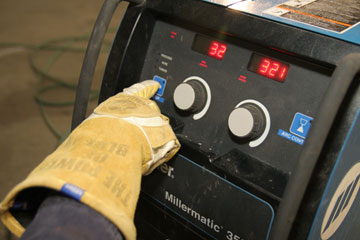 |
The Millermatic 350P allows the operator to easily set the optimal welding parameters and dial in arc length.
|
Eighty of the new standardized TANBs will replace the existing nonstandard boats. Trailered to an appropriate boat ramp and launched, a TANB and its crew of two or three will head to sea to maintain the aids to navigation that mark the nation’s waterways. They are multi-mission capable, however, and are also tasked with providing security to the country’s shorelines and assisting with search and rescue efforts.
Powered by two 150 HP Honda engines, the 26-ft. long boats are capable of speeds up to 38 knots and have a range of 170 miles. A davit, rated at 500 lbs., is located in the front of the boat and used for lifting the navigation aids from the water, and the deck provides more than 100 sq-ft. of working space.
Stepping Up to the (Aluminum) Plate
Jimmy Gravois, who had learned boat making from his father, had more than 30 years experience in building aluminum boats when American Marine Holdings (AMH) approached him. AMH had uncovered the opportunity to produce the new TANBs, but their forte was fiberglass boats. The contract required the winner to have substantial experience in building similar aluminum boats. So AMH turned to Gravois Aluminum Boats, L.L.C., for its expertise.
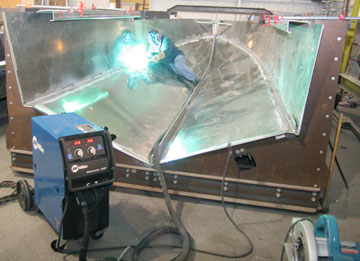 |
By using jigs and the pulsed MIG capabilities of the Millermatic 350P, operators can weld the hull without having the ribs in place, since there is no heat related distortion.
|
Together they would submit a design and bid. Gravois created Metal Shark Aluminum Boats as the trade name for his military craft. Gravois later bought out AMH.
The design Metal Shark submitted was based on one of Gravois’ successful fishing-boat designs, which he modified to fit the Coast Guard’s needs. Once the prototype, including its engines, electronics and trailer, was accepted by the Coast Guard, each subsequent boat had to be substantially similar.
“A marine surveyor inspects the first boat,” says Lt. Bob Post, U.S. Coast Guard, Office of Boat Forces. “Once that is satisfactory, we make sure that each boat is built the same way that the first boat is built. For the Coast Guard, standardization is very important.”
One day is spent thoroughly inspecting the boat in the shop. The next day, the boat is taken out for a three-hour sea trial. Each piece of equipment, from the electronics to the trailer, is inspected. Even metal shavings left on the deck are enough to cause a write up and stop delivery until the problem is addressed. When the boat is delivered to the Coast Guard, it needs to be road- and sea-worthy and ready for its crew.
Metal Shark owes the Coast Guard one boat every 18 days. In the beginning, meeting this schedule presented a challenge to Gravois.
From Fabricator to Manufacturer
As a boat fabricator, Gravois was accustomed to altering his designs to meet individual customers’ needs. Now, to produce a line of identical boats and make the transition from fabricator to manufacturer, it was clear he’d have to change his approach. With AMH’s engineering department, he was able to transfer his design to computer, which then allows Advanced Water Jet of Dallas to precisely cut the parts for four boats at a time.
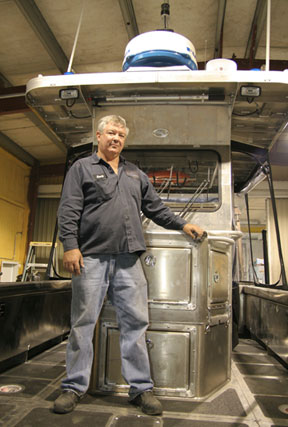 |
Jimmy Gravois on the deck of TANB #22. He and Metal Shark have successfully made the transition from fabricator to manufacturer.
|
“Water-cutting ensures all of the parts are exact and precise,” says Gravois. “I couldn’t attempt to do this much without having all the parts precision-cut. It’s completely transformed the way we were making boats. Even the jig was water cut. It’s accurate to five-thousandths of an inch. When the boat is tacked together, you can throw it in the water and it will float.”
Strike One
To maintain quality and keep up with the production schedule, Gravois had to reexamine his welding operations. The TANBs are constructed from 1/4-in. (bottom, transom and ribs) and 3/16-in. (sides, gunnels and floors) 5086 aluminum alloy. Some parts are TIG welded for cosmetic reasons, but the majority of the boat is MIG welded. Any defect, such as pinholes, overwelding or porosity in the weld, will halt delivery until the problem is fixed.
“We make sure that all welding, brazing and related procedures, including joint design, joint strength calculations, edge preparation, fabrication, and records meet AWS (D1.1 and D1.2) standards,” says Lt. Post. “We inspect every boat to ensure that those standards are maintained.”
When the project began, the Metal Shark team used 250-amp power sources in spray transfer mode and spool guns, which held 1-lb. spools of .035-in. 5000 series aluminum wire. While this worked well for Gravois when he fabricated boats one at a time, it was not suitable for his mass production efforts.
Because of its low columnar strength, feeding aluminum wire has been likened to pushing a wet noodle through a straw. “Birdnesting,” or the tangling of the wire between the drive roll and the liner, is a common, time-consuming and costly problem. Clearing it requires the operator to stop welding, cut the wire, discard the wire in the gun, and refeed new wire through the liner. It also may require cleaning or changing the contact tip because of the burn back caused when the wire stops feeding.
A spool gun helps to eliminate some feeding issues, but introduces a few others, most related to the size and weight of the spool.
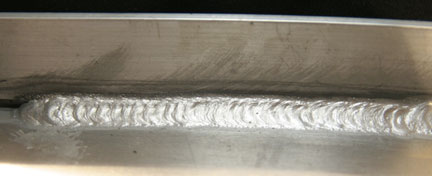 |
Prior to using the Millermatic 350P, long beads such as this, would have been impossible because of the heat input through short-circuit and spray transfer processes.
|
With a spool gun, the operator can’t use a 16-lb. spool as he can with a standard MIG gun. A 1-lb. spool requires the operator to stop after every pound to change spools. Compounding the problem is that as the end of each spool is reached, there still exists the possibility of burn back. When the wire stops feeding, the arc burns back into the tip.
Also, a 1-lb. spool has a smaller circumference than a 16-lb. spool. As it feeds through the tip, it has a curve to it, which can require the operator to hold the gun in an uncomfortable position to keep the wire in the joint.
The 250-amp power source Metal Shark was using worked as intended; however, it presented some issues also. Aluminum, with its higher heat conductivity and its relatively low melting point, is one of the more difficult metals to weld. It is prone to burn through, warping and distortion. Using a spray transfer process put a lot of heat into the welds. In order to keep the heat at a safe level and reduce distortion and burn through, Metal Shark welding operators would need to move their work around to keep the heat from building up.
Again, in some applications, these might not be issues. But to meet the manufacturing process Gravois needed, this equipment was inadequate and initially Gravois’ team struggled to provide one boat every 18 days.
Strike Two
Gravois next tried a pulsed MIG machine with a push-pull gun. Pulsed MIG, or GMAW-P, puts less heat into the work yet maintains many benefits of spray transfer, such as good fusion, high deposition rates and/or fast travel speeds.
In pulsed spray transfer, the power source switches between a high peak current and a low background current. The peak current pinches off a spray transfer droplet and propels it toward the weldment. The background current maintains the arc, but is too low for metal transfer to occur. This is unlike spray transfer, which continuously transfers tiny drops of molten metal.
Pulsed MIG provides good bead appearance because the tiny molten droplets being transferred do not create spatter. Also, because the weld puddle cools in-between pulses, it freezes faster. The puddle is less likely to sag or look excessively convex when welding out-of-position. Operators have so much control over the weld pool with pulsed MIG that they can create beads with a TIG-like appearance.
The problem with earlier pulsed MIG machines was their complexity. Gravois and his welding operators discovered that the machines were too difficult to use and provided erratic results. Also, the push-pull gun they used still gave them feeding problems, especially when they tried running the guns over the 5-ft.-high jigs and down into the hull.
Home Run
For a solution, they turned to Michael Dempsey of National Welding Supply, New Iberia, La. Dempsey recommended the Millermatic 350P all-in-one pulsed MIG welder and XR-Aluma-Pro push pull gun. When the two are combined, they form a complete aluminum welding system that provides smooth and sure aluminum wire feeding along with built-in easy-to-use pulse programs.
They proved to be the answer Metal Shark was looking for.
The Millermatic 350P is an all-in-one MIG/pulsed MIG welder with an output rating of 300 A at 60-percent duty cycle. It can run off either single- or three-phase input power and maintain output even if input power fluctuates by +/- 10 percent. It contains built-in programs for aluminum, mild steel and stainless steel to eliminate operator guesswork in setting parameters. A recent software enhancement added series-specific settings for 4000- and 5000-series aluminum that improves tip life and puddle fluidity.
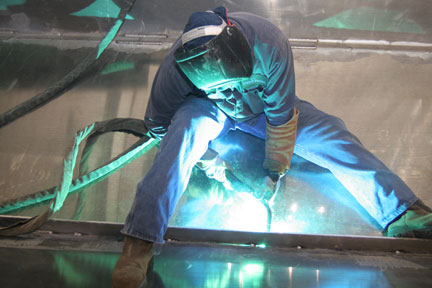 |
The XR-Aluma-Pro gun frees the operator from the limitations of a spool gun while providing positive wire feeding.
|
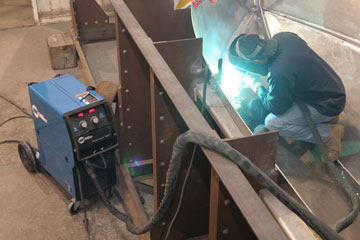 |
|
Because the motors in the XR-Aluma-Pro and Millermatic 350P are synced to one another, the gun can be draped over the hull without experiencing aluminum feeding problems.
|
The aluminum feeding problems Metal Shark experienced with the former push-pull gun, along with the associated burn-back and erratic-arc issues, are no longer an issue for the operators.
“There were a lot of feeding problems with the previous guns. We had a lot of trouble bringing them over the top of the jig and into the hull,” says Gravois. “But with the new system [XR- Aluma-Pro/Millermatic 350P], we can bring the cable over the jig and not have any trouble welding throughout the whole inside of the hull. It’s greatly sped up the process.”
The new system also eliminated the heat-related issues associated with welding aluminum.
“Previously, we’d have to move around the boat to avoid putting too much heat into an area,” says Gravois. “Sometimes we’d even cool an area down with water. We’d have to be very careful not to distort the metal, especially on areas like the T-Tops, where we use 1/8-in. material. We would just weld where the ribs were and then put the ribs in, and then have to come back between all of that and climb through each section and weld out the hull.
“But now we don’t do that. Without the excess heat input, the hull conforms to the jig without the internal ribs. It’s almost an exact fit. Now we make one continuous weld and then weld the ribs down later. It’s 10 times faster, and it makes a much better-looking weld.”
Of the five days spent putting the hull together, Gravois estimates the new system cuts at least one day from the process. Saving one day per boat amounts to about 29 saved days per year. For three welders making an average of $20 per hour, that saves another $13,920 per year.
That’s only a fraction of the savings. For an operator depositing 10 to 16 lbs. of wire per day, not having to switch a spool after every pound of wire saves 40 to 60 minutes per day per operator. With three operators, that amounts to two to three hours per day, estimates Steven Judice, Metal Shark welding supervisor. At an assumed labor rate of $20 an hour, this alone saves Metal Shark a $11,250 per year (see chart).
Additionally, Metal Shark is now able to use 16-lb. spools instead of 16 1-lb spools and 3/64-in. instead of .035-in. wire. This saves them about $1.47 a pound. Using about 150 lbs. of wire per week, this amounts to $11,025 per year. Additionally, assuming one tip is changed per spool change, an estimated 270 tips are saved per week. At a cost of $2.00 per tip, that amounts to $13,500 per year.
In total, by switching to the new system, Metal Shark saves an estimated $49, 695 per year in labor and consumables, paying for its three Millermatic 350Ps in about 4-1/2 months (see chart below).
Wire Consumption
Labor
Consumable Costs
Return On Investment
“The process really changed the way we do things. Now, when I think I have a day to work on something else while they’re welding in that hull, I blink and they’re on me to look at it and give them the go-ahead.”
Having reached boat number 22, Gravois has successfully made the jump from fabricator to manufacturer—Metal Shark Aluminum Boats has doubled their production, and often produce two boats instead of the required one every 18 days. While the cost savings are significant, even more important is the increased efficiency, which allows Gravois to look ahead at competing for other police, Coast Guard and Navy boat projects.